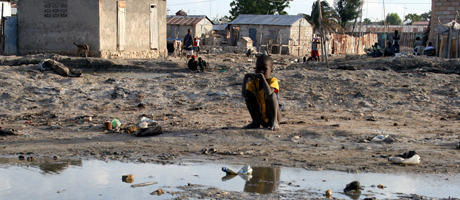An expert in disaster management, Daniel Kaniewski, deputy director of GW’s Homeland Security Policy Institute, served as special assistant to the president for homeland security under George W. Bush. Through the White House position, he chaired an interagency group on domestic readiness and traveled with the president on Air Force One to disaster sites. But he hasn’t seen anything like Haiti. “For an earthquake of this magnitude to occur in a highly populated area of a third-world country is devastating,” he says.
Q: How does the situation in Haiti compare with other earthquakes in recent memory?
A: There are only a handful of earthquakes of this magnitude each year and most of them happen in unpopulated areas. In addition, the quake in Haiti occurred only six miles below the earth’s surface—oftentimes earthquakes occur hundreds of miles below ground. And there’s the fact that Haiti is a third-world country with primarily dilapidated buildings and structures and an almost complete lack of emergency response systems. It’s hard to imagine a more “perfect storm” of a disaster.
Q: What is the first priority for the relief efforts?
A: Locating and rescuing survivors is absolutely the first priority. But by the time rescuers arrive in sufficient numbers, there will be a dwindling number of survivors. The best chance of rescuing survivors is in the first 24 to 48 hours, especially since most people trapped have some kind of injury. The window for them is closing rapidly.
The magnitude of these rescue operations is daunting. There are tens of thousands of casualties and most of the buildings in the area have been destroyed. Search and rescue teams will be in Haiti for weeks sifting through the rubble for victims.
Q: What are some the major obstacles to the relief effort?
A: There are enormous obstacles. Right now, there are few passable roads, no electricity, no running water; in short, no infrastructure that both rescuers and victims require. And unlike the U.S., Haiti does not have a robust emergency response network of first responders to conduct the initial wave of rescues; citizens must do what they can to locate, extricate and care for victims until the international response teams arrive. Coordinating the overall relief efforts will become an increasingly daunting challenge as volunteers and relief supplies stream into the country from around the world.
Q: After the search and rescue phase, how will the long-term relief effort proceed?
A: The next phase will be making emergency repairs to critical infrastructure—restoring electricity, water, transportation, public health and communication systems. I am certain that the U.S. government is already considering how best to do this, because the transition from rescuing victims to restoring infrastructure must be seamless, if not simultaneous.
Q: Will Haiti recover?
A: The near-term recovery prospects for Haiti look bleak. The majority of the homes, roads and public buildings, including hospitals, schools and government offices, were destroyed. The United States and other partners in the relief effort will be there for an extended period, and the road back to normalcy will be a long and winding one for the country.
Photo credit: A. Thompson Photography, creative commons licensed on Flickr.
Comments? Criticism? The conversation continues. We welcome reactions, commentary and story recommendations on our Facebook page.


